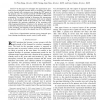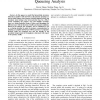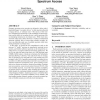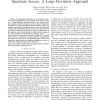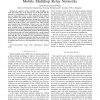102
Voted
TWC
2010
14 years 7 months ago
2010
Abstract--In this paper we investigate the opportunistic spectrum access in temporal domain where a secondary user shares a radio channel with a primary user during the OFF period ...
127
Voted
ICC
2009
IEEE
14 years 10 months ago
2009
IEEE
In this paper, we model the hierarchical structures inherent in cognitive radio networks as the priority queueing system in which primary users interact with the highest priority a...
103
Voted
PIMRC
2010
IEEE
14 years 10 months ago
2010
IEEE
An important parameter in determining a spectrum sharing opportunity is the level of interference power that secondary users may generate towards primary users. It is indicated in ...
91
Voted
IMC
2010
ACM
14 years 10 months ago
2010
ACM
Dynamic spectrum access networks are designed to allow today's bandwidth hungry "secondary devices" to share spectrum allocated to legacy devices, or "primary ...
108
Voted
WIOPT
2010
IEEE
14 years 11 months ago
2010
IEEE
Abstract—Development of dynamic spectrum access and allocation techniques recently have made feasible the vision of cognitive radio systems. However, a fundamental question arise...
115
Voted
INFOCOM
2010
IEEE
14 years 11 months ago
2010
IEEE
Abstract—The queueing performance of a (secondary) cognitive user is investigated for a hierarchical network where there are N independent and identical primary users. Each prima...
109
Voted
ICASSP
2010
IEEE
15 years 29 days ago
2010
IEEE
— In cognitive radio, spectrum sensing is a key component to detect spectrum holes (i.e., channels not used by any primary users). Collaborative spectrum sensing among the cognit...
124
click to vote
WCNC
2010
IEEE
15 years 4 months ago
2010
IEEE
Abstract—In cognitive mobile multihop relay (CMMR) network, the mobile user as the primary user is allocated with the channel for transmitting data. Relay station as the secondar...
115
Voted
WCNC
2008
IEEE
15 years 7 months ago
2008
IEEE
—We study a cognitive network consisting of multiple cognitive users communicating in the presence of a single primary user. The primary user is located at the center of the netw...
WCNC
2008
IEEE
15 years 7 months ago
2008
IEEE
— In an opportunistic spectrum sharing system, secondary users equipped with cognitive radios opportunistically access spectrum that is not being used by the primary users, i.e.,...
